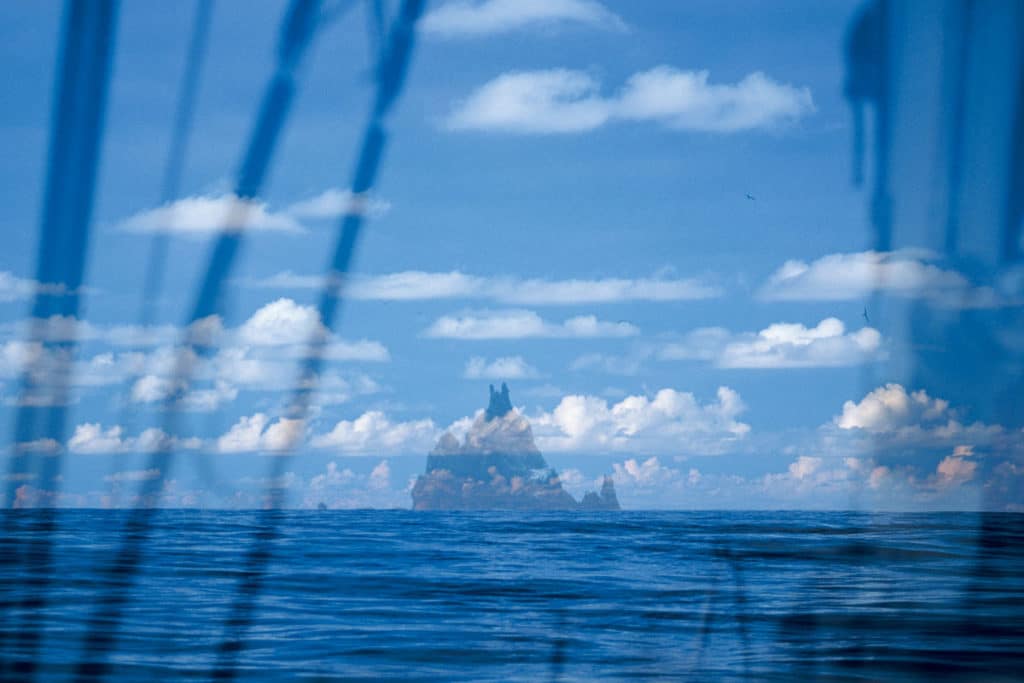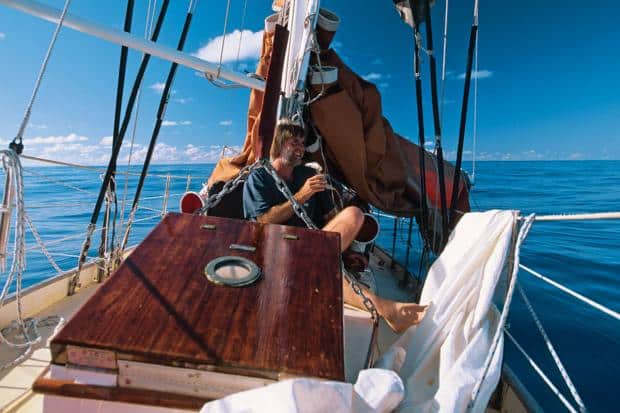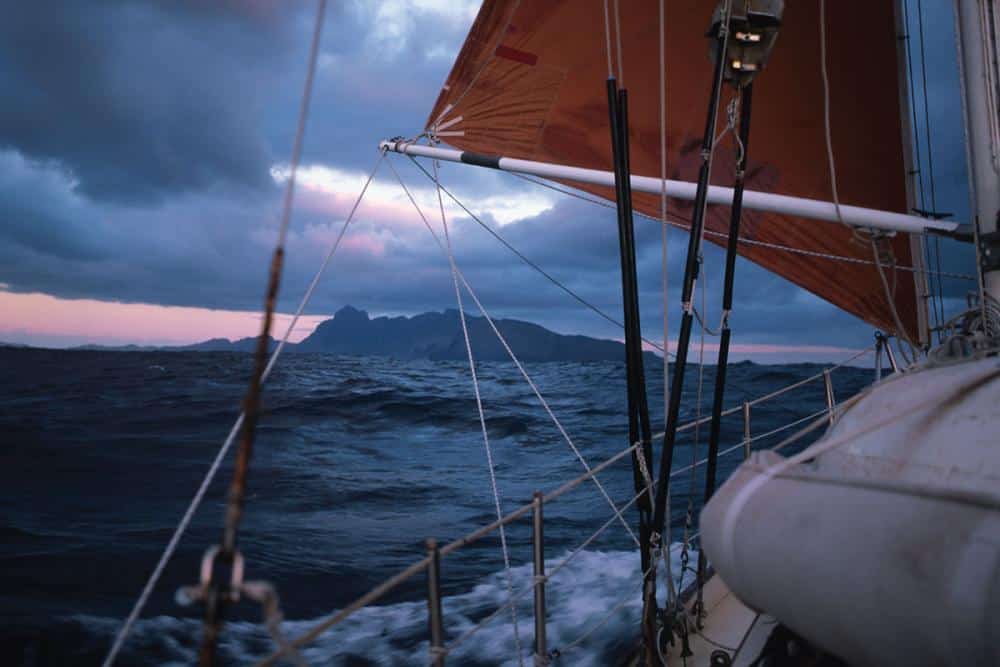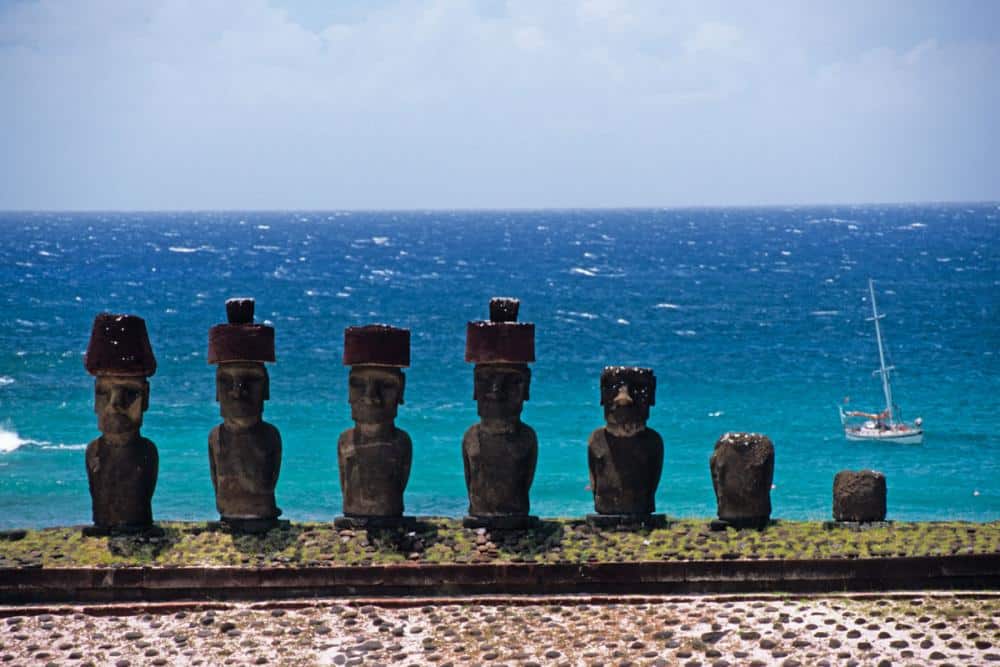
Lost Island
The search for an island off the Chilean coast turns into a 5,000-mile wild goose chase that unfolds oh, so slowly.
My Wanderer III is a small boat, and Klaus is a big man. For him to climb out of the uncomfortable cockpit, down the companionway, and into his narrow bunk is strenuous in this rolling sea, the remnants of what must have been a hard blow down in the Southern Ocean. Being becalmed in this 4-meter swell requires physical, as well as mental stamina. Once lying down, he admits that he hadn’t imagined passagemaking to be quite like this: The sails slap unbearably, an incessant, maddening clanging comes from the lockers, and from somewhere else an annoying squeak. Finally in the bunk, the back muscles protest against the constant motion, and often all this misery is accompanied by snoring too.
“It’s a madhouse,” says Klaus.
“A mad boat,” I correct him.
We haven’t even come very far yet, only about 400 nautical miles on our circuit of all Chile’s oceanic islands in the East Pacific, from Puerto Montt back to Puerto Montt. Five thousand nautical miles in three months, that’s the plan. But whenever I include Isla Podestá in our itinerary, Klaus calls me crazy. “An island 900 nautical miles west of the Chilean mainland? You must be joking,” he says. “Between Isla Róbinson Crusoe and Easter Island? Never!”
Klaus has been Chilean for 68 years and had never heard of the place, except from me.
I first encountered Isla Podestá half a year earlier, by chance, on the fifth day of a Southern Ocean storm. My wife, Kicki, and I had been stuck at 40 degrees south, 1,000 nautical miles from Chile’s coast, for days. We were beset by headwinds instead of the usual westerlies that are normally so dominant around the East Pacific High. We lay powerless in our sea berths, drifting backward under bare poles, pitching heavily into seas that broke over us. It was our 62nd day at sea. We still had fresh water, but not a lot. With consistently low barometric pressure, I was looking for alternatives. To fall off for Easter Island to the northwest meant retreat, defeat and still promised no safe harbor. I measured 800 nautical miles on my chart — a well-used specimen with coffee stains, old position marks and taped-on bits of paper to enlarge the ocean. That’s when it caught my eye, not as an alternative, but as a dot: Isla Podestá. That was my first awareness of it.
Klaus’ well-worn Chilean nautical pilot book describes Podestá as an island two-thirds of a nautical mile in circumference, with a sand bank that reaches 2 nautical miles to the southwest and a height of 12.2 meters. That’s not even the height of Wanderer’s mast.
What would one find there? Probably a mysterious collection of flotsam, I’d guess.
“Something for Christie’s auctioneers,” Klaus reckons. But that’s if Podestá actually exists. And in the end, it’s fairly immaterial, since we can’t load much of anything onto the 30-foot-long Wanderer.
Podestá’s elevation, as recorded in Klaus’ book, dates back to an observation from 127 years ago. How high might it be today? Isla Róbinson Crusoe, at 915 meters high and perfectly visible, doesn’t require such speculation. It’s the first we encounter of our Chilean ocean islands, and colder than in my childhood dreams. It’s there that we drop the hook for a visit.
It’s raining, and three of us sit on the veranda of the Villa Green Hosteria talking and letting the time pass.
“I’ve studied everything: in libraries, private collections, in South America, in Europe, letters, reports, charts,” Bernard Kayser, an American from Chicago, tells us. Punctually at 6 p.m., dusty and dirty after a day’s work digging for lost treasure, he comes to relax on this veranda. He spins a convoluted tale of British pirates and much gold, a burial, a deadly shipboard explosion in Valparaíso, a code, a plan and several-hundred-year-old notes with a reference to a tree that has long since become victim to erosion. He is speaking of a treasure for which he has been digging for five years. He is the second largest employer on the island each summer.
To me, his Róbinson Crusoe treasure and Isla Podestá share at least one thing: vagueness. His probings are like those of the Chilean navy, the Armada. Ships were sent in search of Podestá several times:_ Pinta, Pardo_, also in 1957 the sail training ship Esmeralda. They initiated a systematic, 1,350-kilometer-square grid-search around Podestá’s alleged coordinates of 32 degrees, 14 minutes south and 89 degrees, 8 minutes west.
The Armada had good weather and excellent visibility, probably just like what we have as we prepare to put to sea. “No wind and clear skies,” reports the meteorological chart in the Róbinson Crusoe harbormaster’s office. For weeks I’ve been keeping a skeptical eye on the windless East Pacific High, 550 nautical miles distant. It’s centered where Podestá ought to be. I know all too well that such conditions are impossible to counter with just 40 liters of diesel in our tanks.

For much of this voyage, the sea is a flat calm, and the crew lounges on deck.
But right now in this harbor there’s a breeze that pulls us on. So I find myself in front of an Armada official who, like his counterparts throughout Chilean waters, is noting down our destinations precisely. They are all islands that are seldom visited and without anchorages: Isla Más Afuera, known today as Isla Alejandro Selkirk, San Ambrosio, Sala-y-Gómez. Isla San Félix is forbidden because it’s in a military exclusion zone. And Isla Podestá is not known to him.
That’s exactly what I find so fascinating, that nobody knows about it, even though I’d plainly seen it on various charts. In order to point the island out to him I turn to the topographical wall chart that I recall from an earlier visit as being behind me. I had seen Podestá on it when we arrived here. But as I turn, there is nothing but bare stucco. I’m confused; how could I not have noticed? What happened to it? Within this past week the deep blue chart — and Podestá along with it — had been taken down, leaving a blank wall.
The summer sea, the sky, the horizon, everything has become gray. One hundred nautical miles west of Isla Róbinson Crusoe, Isla Alejandro Selkirk is a 1,600-meter high, 1.5 million-year-old mass of the same hue. There isn’t a sign of the 17 families that fish crayfish here from September to April. But over the VHF radio we are warned about anchor-swallowing rubble. So we let Más Afuera, as the island is known on older charts, slip astern and soon allow the windvane to control the course.
For days, under an endlessly bleak cloud blanket, the southerly blows us northward. Away from the windless center of the East Pacific High, the Walker Log counts the miles, birds instead of fish eye our lure, and Klaus’ Tahitian sun cream — his South Seas thermometer — remains as hard as rock. So far we’re getting no closer to understanding Podestá’s either physical or cartographic existence.
Meanwhile Klaus and I have started discussing the length of a nose. Pinocchio was the name of the Italian captain of the vessel Barone Podestà, who discovered and described Isla Podestá in 1879. Maybe it was a mere figment of his imagination, something to ensure his immortality? If so, he succeeded, as the island was handed on from chart to chart since it was sighted. Imagination has always played a part in the history of cartography.
Klaus’ imagination has sprung to life too. He dreams of a playa at Isla San Ambrosio, and of celebrating Christmas with lobster. Around New Year’s, seasonal fishermen usually camp there, his pilot book says. He is full of hopes. Those dreams disintegrate in sight of San Ambrosio’s eastern cape. Rough swells crash on vertical volcanic rock. Farther along the northern cliffs we find a wedge-shaped inlet with foaming water, 40 meters deep. The rocks beyond obviously are what is referred to as the beach, and we see Spanish names hewn into them. To the right, there’s a rusty metal bar for lifting and lowering fresh water and the catch. We spot an old oven crumbling out in the open, and then nothing else. These are the remnants left by fishermen perhaps 100 years ago. Clearly, no one has been here for a while. And now, it’s me who is doubtful.
“I can’t trust the translations of your pilot books anymore, Klaus,” I chide him. “They’re all dreams, these Chilean handbooks.”
Our presence near the island is discovered the next morning from the 10-miles-distant San Félix. During the border conflict with Peru, San Ambrosio was part of the forbidden zone, and together with San Félix’s airstrip and navy base, it continues to be off limits to visitors. Citing ornithological interests, we ask at least to be allowed a rounding of the nearby towering Roca Catedral de Peterborough outcropping. Permission granted.

Pushed on by the trades, Wanderer III_ closes on Islas Juan Fernández, off the coast of Chile._
The wind has turned easterly and is pushing our poled-out sails. The bleakness of Chile’s ocean, with its untouchable islands, is receding behind us. The gray is breaking up and the sun is coming through. After a week under leaden skies, the South Seas shimmer, and a tropical feel mixes into our lives. To be pushed westward by the trades is a well-known pleasure, but on this occasion it’s more short-lived than I remembered. Already, just three days into it, a deep red sunrise heralds a calm.
While we still have a breeze, things are more civilized than in a long time. Klaus serves coffee with a soft-boiled egg and freshly baked bread. All is tidy and calm.
Back on Isla Róbinson Crusoe, Leo Pisas, fisherman and mayor, had come aboard and answered my query about Podestá hesitantly, saying, “Maybe that’s the island we call Isla Blanca.”
So our search continues. Something exists, or existed, beyond the horizon — it’s just not certain whether Pisas’ Isla Blanca is identical with Podestá.
Could Podestá instead be Yosemite Rock, sighted in 1903, and looked for, but not found, in 1904 and 1909? Or Emily Rock, last seen in 1873? There is also Sefton Reef, sighted in 1908. But what, I wonder, precisely distinguishes an unconfirmed rock from an unconfirmed island? Perhaps the answer is that every seafarer will take pains to avoid a rock, a reef or a shoal. But islands attract; one wants to reach them and explore them.
We want to explore Podestá, if we can. But instead we drift for days in an endless calm. The only sound is the pensive slapping of the sails, and louder, the ticking of the clock. We’re at a crawl. It’s as if the Pacific were miserly and can only give us warmth to melt Klaus’ sun cream, but not wind to be on our way. This too is different from how Klaus imagined passagemaking. Not to be in control, to rely on whims, worries him, the airplane pilot. Slowness is incapacitating.
A slightly crinkled ocean surface gives the pretense of movement, but actually it’s masking lethargy. Klaus counters this windlessness with a bucket. On the foredeck he pours seawater over himself several times a day.
This water is full of single-celled creatures. Here in the ocean’s upper layer I see countless floating bits: plankton, simple life. But among them I see something else. Upon careful inspection I discover tiny particles of plastic. I wish I were imagining it, but the deep blue sea surface is strewn with a loosely woven carpet of civilization’s rubbish. In 1947 Thor Heyerdahl drifted near here on_ Kon Tiki,_ through a trash-free ocean full of life.
One can see this carpet only in a calm. Once the wind blows and the waves come, the carpet rips apart and the ocean sparkles. Motion hides so much, pollution included.
Incredulous, I lean over the railing and stare deeper into the sea. Fifty meters under the keel, details fade into the deep blue. It’s rare that I contemplate the abyssal landscapes while I float above them. But Podestá’s mystery has caused me to pull out the Chilean sea-bottom chart showing the Nazca Plate. The many volcanoes on it appear cloned. As part of an underwater mountain range called Cordon Roggeveen, I see a dot on a perfect cone: Isla Podestá it says, and below it in red letters: Chile. This dot, now 350 miles distant, is our nearest neighbor for weeks.
We eat, we drink, we read, we’re silent. At times we travel at a knot, sometimes a knot and a half, often less. Our movement comes always without any ocean gurgling, and so is nearly unnoticeable. To preside over motionlessness during night watches is tiring. Daytime is easier. Then, seen from the shady oasis of the cockpit, the ocean becomes a stage with an uninterrupted array of world premiers. To the rest of the world, we mimic Podestá. Nobody knows where we are.
For 17 days the windless dome of the East Pacific High unites us with Podestá, without any chance of reaching it. Podestá remains untouchable. It eluded the Chilean Armada, and remains today as a phantom island, not seen since Capt. Pinocchio.
But what if Capt. Pinocchio actually did discover an island in 1879, only for it later to disappear? Geophysical phenomena might explain its coming and going. The oceans change, after all, even within the course of a century. Instead of biodiversity, we are surrounded by plastic rubbish; instead of a 12.2-meter-tall island, nothing?
In the buzz of our modern world we act as if the oceans are full of life; perhaps this is as real as Podestá on our charts. Not finding the island is not the same as its not existing. Capt. Pinocchio saw something back then, on the ocean, where fantasy so easily blends with reality. Edges blur when wind and sea fall quiet. The days with and the days without wind melt together. Hours strangely lengthen, relationships find new forms. The eye sees solid rock in puffy clouds, or a threatening reef in a school of jumping fish. And when moonlight paints the sea with surrealistic hues, islands appear everywhere. There is no limit to potential deceptions.

Wanderer III lies at anchor in the still-rough lee of Easter Island.
But the presence of frigatebirds offers orientation. Eventually on our journey, their screeching becomes part of our days and there, small and rocky, we slowly make out a darkened lighthouse, red and white striped. Sala-y-Gómez is real. It offers minimal protection, and we anchor on bands of sand and coral in 30 meters of water.
Later we spend 13 nights under the supervision of a moai in Hanga Piko, the tiny harbor at Easter Island, another tangible reality.
Yet having left Easter Island on a course south of the East Pacific High, at the end of a 5,000-nautical-mile circle in search of an unseen island, absolutes are again relative. Dense fog at the Chilean coast swallows all certainty of our position. Like Capt. Pinocchio, we lack electronic instruments and we depend on sextant sights, which we aren’t getting. So everything remains approximation, assumption, possibility. I hear unnerving sounds: gurgling water, bird cries, then sea lions in the night.
Many months later, back in Puerto Montt, I sit at a computer and explore Google Earth. In front of the screen I become a navigator on a totally different journey. Clicking the mouse I advance with ease. Without coming upon the East Pacific High, I find answers. Podestá stands clearly before me. Hardly 4 miles from its charted position, at precisely 32 degrees, 18 minutes, 01.91 seconds south and 89 degrees, 08 minutes, 07.78 seconds west.
Is this fantasy or reality? For a phantom island, the position is absurdly precise.
Thies and Kicki Matzen, aboard Wanderer III, are now on the Atlantic coast of South America. This article first appeared in the January 2014 issue of Cruising World.








